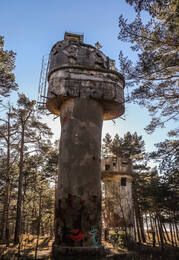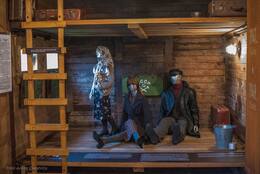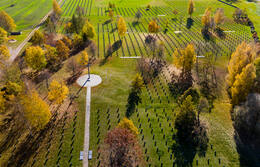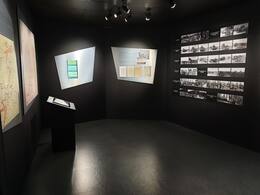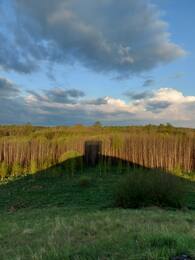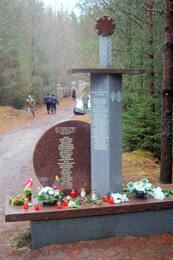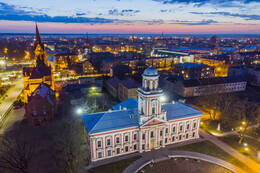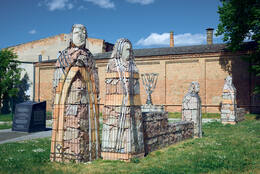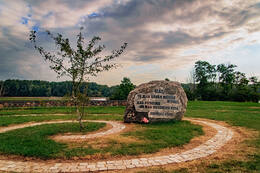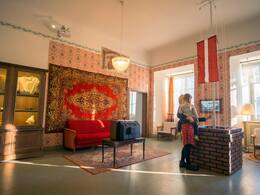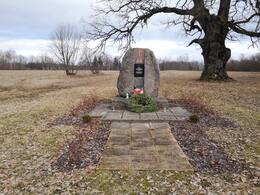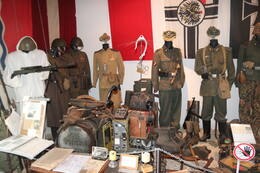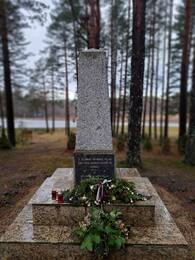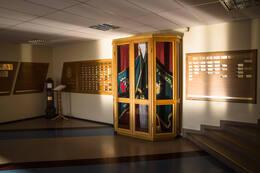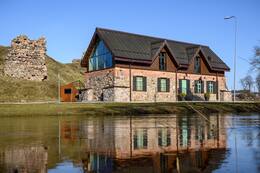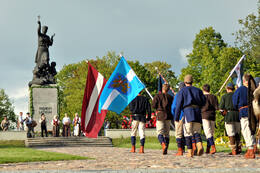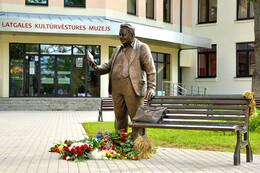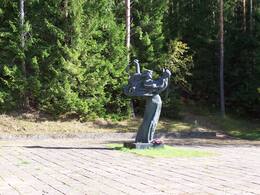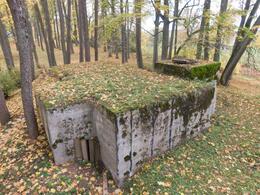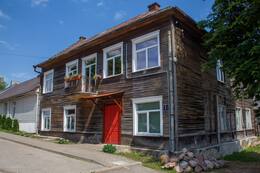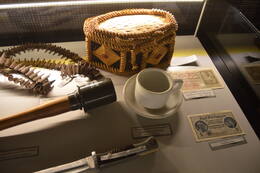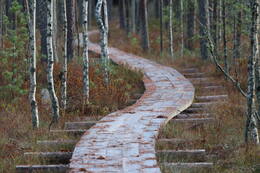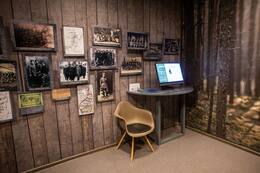World War II and its Aftermath – Soviet Occupation in Southern Latvia and Latgale
Karosta, the Military port of Liepāja (tour)
The Karosta is the largest historical military territory in the Baltics and occupies almost one third of the entire territory of Liepāja. The Karosta is a unique compound of military and fortification buildings on the shores of the Baltic Sea with a special meaning in the history and architecture of Latvia and the world. The Karosta features such military heritage sites as the North Pier and forts, the Redan, Karosta Prison, Karosta Water Tower, St. Nicholas Orthodox Maritime Cathedral, Oskars Kalpaks Bridge and others.
Cattle wagon used for deportations – museum at Skrunda train station
To commemorate the deportations of June 1941 and March 1949, a memorial stone and a four-axle wagon, which also serves as the museum dedicated to deportations, was erected at the Skrunda railway station. This is the first wagon-type museum in Latvia that holds a permanent exhibit of photos, letters, memoirs, documents and various items made by the people deported from the Skrunda station. Skrunda station was a location where deportees were gathered, and one of the three stations in the region to which people from the Skrunda and the Kuldīga area were brought. In 1941, the family of the first President of the restored Republic of Latvia, Guntis Ulmanis, was deported from here to Krasnoyarsk Krai in Siberia.
With the help of deportations, the Soviets dealt with supporters of the national partizans’ and at the same time intimidated the remaining rural population, forcing them to join the collective farms.
Saldus German Soldiers' Cemetery
Saldus German soldier's cemetery is located on the Saldus-Ezere highway. Around 25,000 German soldiers, as well as some Latvian legionnaires, were reburied in the 8-hectare cemetery. Reburial has been taking place since 1997.
From May 1 to October 1, an exposition on the Battle of Kurzeme can be seen in the memorial room. During this period, the memorial room is open on weekdays from 9:00 a.m. to 5:00 p.m., on Saturdays and Sundays the cemetery also has a tour guide. The registers of soldiers buried in Saldus German soldiers' graves and fallen soldiers throughout Latvia are also available.
Ezere local history repository “Muitas Nams” (Customs House)
The Ezere Customs House is located in Ezere near the Saldus-Mažeikiai highway at the Latvian-Lithuanian border. The act of surrender of the German Army units ‘Kurzeme’ (Kurland) surrounded in the so-called ‘Courland Pocket’ was signed in this building on 8 May 1945. It is believed that World War II actually ended in Ezere. The customs house has an exhibit covering the events of the end of World War II and exhibits detailing the history of Ezere parish from ancient to modern days. In the morning of 7 May 1945, the commander of the Leningrad Front, Marshal L. Govorov, sent an ultimatum to the command of the army group ‘Kurzeme’ to lay down arms. The act of surrender was signed by the involved parties on May 8 and it detailed the procedure of surrender, weapons collection points, documents and information to be submitted and other practical measures.
Soviet air force target firing ground in Zvārde
Zvārde landfill is located in Zvārde municipality, Saldus region. It is a former military aviation training ground of the USSR, covering more than 24 000 hectares.
The territory of the former airfield is home to several sites: the Officers' Kurgan, the ruins of the Zvārde and Ķērkliņi churches, the Rīteļi cemetery, the former army base "Lapsas", and others. Until the Second World War, the site of the observation tower was home to the "Vairogi" house. During the construction of the polygon, what was left of the farm - walls, the remains of the apple orchard, and part of the ruins of the Veczvārde manor - was piled together to form a mound and the observation tower was built on it. It was used as an observation point for coordinating the army's training manoeuvres. This place is popularly known as Kurgan. The mound overlooks the former training ground and the wooded areas of Zvārde Nature Park and Nature Reserve. A good place for bird watching. The surroundings of Kurgāns are not landscaped.
Īle National Partisan Bunker
The bunker is located in the Īle forestry of Zebrene Rural Territory, at the turn-off from the P104 Biksti-Auce Road.
The Kārlis Krauja Group of Īle National Partisans was formed in 1947. V. Z. Brizga (alias K. Krauja) was appointed the commander of the group. In October 1948, the Krauja Group merged with a group of Lithuanian national partisans. Krauja Group operated in Jelgava District and consisted of 27 national partisans. In October 1948, Krauja Group built an underground bunker in Lie lauce Parish, Jelgava County, not far from the Īle Forestry, 300 metres to the north of the “Priedaišu” house. Its total length, including battle passages, was 45 metres. 70 remote-controlled mines were planted around the bunker. The bunker was equipped with a furnace, a well, a toilet, and a storage room.
On 17 March 1949, the 24 partisans who were in the bunker at the time fought their last battle against the 760-strong troops of the Ministry of National Security or Cheka. After the battle, 9 members of the group were arrested, while 15 fell in the battle, with eight of them being Latvian and seven being Lithuanian. In 1992, the Home Guards, together with the Daugavas Vanagi (Hawks of the Daugava), unearthed the bunker that had been blown up. A White Cross, a memorial stone and a granite statue were erected at the site. Inside the bunker, you can see a stove, a table, and narrow benches on which the partisans slept.
Information boards and memorial stones with the names of the partisans have been installed at the bunker.
St. The tower of the Trinity Church in Jelgava, Akadēmijas Street 1, where Egon Užkurelis hoisted a homemade Latvian flag in 1952
In the tower of the St. Trinity Church in Jelgava, which was destroyed in the Soviet-German war in July-August 1944, on October 12, 1952, Egons Užkurelis, who was only 14 years old at the time, together with his friend Jānis Ģēģeris, who was a year older, hung a homemade Latvian national flag. This date was chosen because it was a Sunday when the Jelgava championship motorcycle racing took place in Pārlielupe, where many people gathered and from there the church tower could be clearly seen. The flag was made from a bed sheet, painted with watercolors. The way it was made later allowed the Chekists to guess that the flag-raisers should be sought among the students.
E. Užkurelis and J. Ģēģeri were arrested on October 23, 1952, followed by interrogation in Jelgava and at the Ministry of State Security of the Latvian SSR in Riga at the Corner House. The Criminal Court of the Riga Regional Court accused E. Užkurelis and J. Ģēģeri of anti-Soviet propaganda and agitation and participation in a counter-revolutionary organization. On January 10, 1953, E. Užkurelis was sentenced to five years in prison, and J. Ģēģeris to 15 years. E. Užkurelis was detained in Riga Central Prison for seven months until April 12, 1953, when he was released on the basis of an amnesty.
Jelgava History and Art Museum of Ģ. Eliass
Jelgava History and Art Museum of Ģ. Eliass is located in a building that is called Academia Petrina (Peter’s Acad emy). It was built in 1775 as the first university in Latvia and is one of the few public buildings in Jelgava to survive and be restored after World War II. In the summer of 1944, Jelgava lost almost everything – a large part of its popu lation and historic buildings, which were hardly restored after World War II. The predecessor of the current museum – the Kurzeme Provincial Museum – was founded in 1818. It was the second oldest museum in Latvia and the first one established outside Riga. The museum has been housed in the Academia Petrina building since 1952. Today, the museum features permanent exhibitions on the renowned Latvian artist Ģederts Eliass (1887–1975), the prehistory and Middle Ages of the Zemgale region, Jelgava during the era of the Duchy of Courland and Semigallia (1561–1795), the Courland Governorate (1795–1918), and the period of Latvia’s independence (1918–1940). The museum exhibition “Life Continues Under Foreign Rule” explores life in Latvia during the German and Soviet oc cupations. The virtual exhibition “Wars and a Soldier Through the Ages of Jelgava” offers insight into the various wars that have affected Jelgava, including historical events from the First and Second World Wars.
Memorial "Synagogue Garden"
The memorial is located in the city centre, not far from the Bauska Municipality Tourist Information Centre and Town Hall Square.
It was created thanks to the initiative and donations of the descendants of Bauska Jews living in Israel, the USA and Great Britain, as well as the support of the Bauska Municipality Council and Latvian Jewish congregations and communities. The memorial was designed by sculptor Ģirts Burvis. It is the same size as the former Bauska Great Synagogue, and the stone images symbolise Jews coming out of the place of worship after the service. A symbolic bimah is situated in the centre of the memorial; it is a raised platform or table used in Jewish religious rituals in the synagogue. An inscrip tion on it reads: “A tribute to the Jews of Bauska, who lived here for centuries and built this city, and who were killed by the Nazis and their local helpers in 1941. Honouring the memory of the Jewish people – the descendants of the Jews of Bauska and the people of Bauska.” In 1935, almost 800 Jews lived in Bauska.
After the Nazi occupation, in July 1941, many Jews were arrested and deported, and around 700 Jews were shot. Bauska Great Synagogue was destroyed during World War II
“Soviet Years” Exhibition at Aizkraukle Museum of History and Art
In November 2018, to celebrate the centenary of Latvia, the “Soviet Years” exhibition was opened at Aizkraukle Mu seum of History and Art – the largest exhibition in the Baltic states dedicated to the cultural and historical heritage of the 1950s–1980s. The exhibition is spread over three floors in an area of 1,060 m2. It reflects Soviet life in its multiple facets: everyday life, work and leisure, education and culture. Soviet-era cars are on display on the ground floor. A separate library – the Red Corner has been set up. A wide-ranging exhibition invites visitors to explore everyday life and apartment interiors during the Soviet era – furniture and household items, tableware, textiles and electrical appliances. Other exhibition spaces are dedicated to emigration, So viet repressions, everyday life, medicine, state structures, tourism and sport, childhood and education. Soviet military paraphernalia and uniforms are also on display among various exhibits.
A memorial dedicated to the mothers of Siberia in the "Garden of Destiny"
The Garden of Destiny is located on an island of the River Daugava, near the ruins of Koknese Castle. It is designed as a landscape architectural ensemble and is dedicated to the memory of the Latvian people that Latvia lost in the 20th century – those who fell in wars, were repressed, were forced into exile or otherwise suffered due to their political opinions. Like the Freedom Monument in Riga, the Garden of Destiny was created thanks to donations. In cooperation with the Latvian Association of Politically Repressed Persons, a memorial ensemble for women de ported to Siberia – mothers of Siberian children – has been created in the centre of the virtual House of Silence. Two boulders engraved with the words “Mother, you gave me life twice. When I was born and when I did not starve to death. A child of Siberia.” remind one of the selflessness and great sacrifice of mothers. World War I trenches have been preserved on the grounds of the Garden of Destiny. A memorial to the Latvian Riflemen has been created there, which was inaugurated on the 100th anniversary of the founding of the Riflemen Regiments. The composition of the site consists of two parts: The group of Latvian boulders symbolises those who stayed at home, while the row of boulders in the trenches of the First World War symbolises the Latvian Riflemen. The boulders were se lected and artistically arranged by sculptor Ojārs Feldbergs.
Exhibition "Struggles for freedom in the 20th century" in Jēkabpils History Museum
Located in Krustpils Palace
Viewable exhibition "Fights for freedom in the 20th century"
Soviet repression. Hard memories. Sitting here in a club chair, you can listen to fragments of the book "Those were the times" by Ilmars Knaģ from Jēkabpils. On one of the walls of the room, a list of townspeople deported to Siberia slides dispassionately, like the credits after a movie. There you can watch an amateur video about the removal of the Lenin monument in Jēkabpils on the old TV. Visitors are interested not only in the content, but also in the technical possibilities - how did this film get on the old TV.
It is possible to listen to the lectures prepared by the museum specialists at the Jēkabpils History Museum or apply for an excursion: Jēkabpils and its surroundings in the First World War, Jēkabpils in 1990, the time of the Barricades, the deportations of 1949 - 70, Jēkabpilians Cavaliers of the Lāčplēš Military Order, etc.
The average duration of lectures is 40 min. Information and registration for lectures by calling 65221042, 27008136.
Jēkabpils History Museum is located in Krustpils Castle. In 1940, after the inclusion of Latvia in the USSR, the 126th Rifle Division was stationed in Krustpils Castle. During the Second World War, the castle housed a German infirmary, and after August 1944, a Red Army war hospital. After the war, Krustpils Castle with the adjacent manor buildings were occupied by the central warehouses of the 16th Long-range Reconnaissance Aviation Regiment and the 15th Air Army of the Soviet Army.
Monument to National Partisans in Jersika
The memorial stone is located near the Jersika railway station. It is engraved with the inscription: “LTS(p)A – Latvijas Tēvzemes sargu (partizānu) apvienības cīnītājiem” (For the Fighters of the Latvian Union of the Guardians of the Fatherland (Partisans)). The Union of Partisans united national partisans of six Latvian districts in the struggle against the communist occupation regime in 1945–1955. The memorial stone is the first stop on the hike “Jersika-Vanagi. Nacionālo partizānu leģendām pa pēdām.” (Jersika-Vanagi. On the Trail of the National Partisan Legends.) The route starts at Jersika station and offers an insight into the history of the national partisan movement, its most prominent figures and their activi ties. Further on the trail: the site of the national partisan bunker hidden in the forest; the place of the founding of the Fatherland Guards (Partisans) Association as mentioned in the testimonies; and the memorial place “Avotnīca” (in Latgalian “Olūtneica”) in the forest, where a bonfire has been set up. The destination of the hike is Vanagi Church, where the priest Antons Juhņevičs served. The film “Segvārds Vientulis” (Alias Hermit) was made here (producer Normunds Pucis). The film tells the story of a priest, who was involved in the national partisan struggle in post-war Latgale. The route also bears evidence of former farmsteads: stately oaks and ruins of buildings.
It passes through forests, swamps, fens, meadows, and country roads. The total length of the hike is approximately 22 km and it can be completed in 6 hours.
Jersika National Partisan Hiking Route
A hard-to-find natural object. Hike length: approximately 22 km, can be completed in approximately 6 hours.
Hike length: approximately 22 km, can be completed in 6 hours.
Difficulty level: medium fitness hike.
Starting point: Jersika Elementary School (can be reached by train, bus).
End point: Vanagu Church (public transport does not run on weekends).
Note: The route includes a swimming break (during the summer season), fishing opportunities, a picnic area, and one public toilet. The route is also suitable for school-age children who already have experience in hiking of this length.
Go on a hike from Jersika to Vanagi, allowing yourself to be challenged in endurance, as the hike leads through forests, swamps, moors, meadows and country paths, and in the historical knowledge of the most prominent figures of the national partisan movement, their activities, see the most significant places about which local legends and written memories of fellow citizens are told. The path begins at the Jersika elementary school and leads to a memorial stone under an old oak tree, further along the way including the Jersika railway station. The inscription on the stone reads “LTS(p)A – For the fighters of the Latvian Fatherland Partisan Association. LTS(p)A united the national partisans of six Latvian districts in the fight against the communist occupation regime in 1945-1955”.
The walk continues along the railway tracks and winds along Lake Jersika, where the forest presents natural treasures: spring-flowering primroses and common sedge. The smell of primroses indicates that you are approaching the bog, but in spring it is especially surprising to see them blooming. A lazy walk is not possible, several ditches must be overcome, crossing the bog provides a tempering - water remains in the moss at every step, cranberry berries shine in the bushes. The bog is replaced by a forest and evidence of the former settlement of these places in homesteads - stately oaks, ruins of buildings, the site of a national partisan bunker surrounded by young growth. The path continues to the place mentioned in the testimonies as the place of founding of the Fatherland Guards (partisans) association. The forest massif also hides the memorial site “Avotnīca” (“Olūtneica”), where a campfire has been set up. The diversity of the forest is surprising, as is the width of the ditches. The destination of the hike is Vanagi Church, where priest A. Juhņevičs served, and about whom the film “Segvārds Vientulis” (directed by N. Pucis) tells the story.
WW2 – World War II Exhibition
WW2 – World War II exhibition in Aglona or the War Museum was established in 2008 and is one of the most extensive and interesting expositions of this kind in Latvia. The col lection has been continuously supplemented with new acquisitions and stories of war participants and people of the wartime generation.
The core of the museum consists of weapons, equipment, ammunition, and uniforms used during World War II. In ad dition, there are household objects, fragments of aircraft wrecks and other exhibits. One of the most precious and unique exhibits is the Feldpost (field post) correspondence between Oberleutnant August and his lover Martha, which created a dialogue between two loving people with a happy ending during the period of the five years of war.
Wartime chronicles are displayed in the background of the exhibition. The exhibition is not politicised and reflects both sides of the war equally, allowing viewers to perceive it without making judgements of good or bad, which makes the exhibition easy to understand
Monument to the Latvian Freedom Struggles at the site of the battles of the 3rd Jelgava Infantry Regiment
Monument to the 3rd Jelgava Infantry Regiment's January 16, 1920, freedom struggle in Latgale. With the inscription: “The place of the 3rd Jelgava Infantry Regiment's battles, the victory march through Latgale. 1920.16.I. We brought the sun, freedom and independence to Latvia”
The monument was unveiled in 1936. On August 16, General Žanis Bachs (1885–1941) consecrated it by Pastor Ādams Vizulis (1891–1970). The author of the monument's design was Engineer Zilēvičs.
The Latvian War of Independence (1918–1920) operation to liberate Latgale began on January 3, 1920. By mid-January, the Latvian and Polish armies had liberated Daugavpils and most of southern Latgale up to the Dagda–Indra line from the Bolshevik forces that had seized power in Russia. On January 9, the Latvian army began its offensive in Northern Latgale, rapidly advancing towards the Kārsava and Pitalova stations.
In the middle between the two directions of attack remained the Bolshevik-controlled area around Varakļāni, Viļāni and Rēzekne. On January 20, Latvian army units began the operation to liberate Rēzekne. Rēzekne was liberated on January 21. The Latvian army, across the entire expanse of the Eastern Front, reached the border of Latvian-inhabited lands by the end of January. Already on February 1, Soviet Russia signed an armistice agreement with Latvia.
With the victory in the Battles of Latgale, Latvia's eastern border was secured and the opportunity to annex Latgale to Latvia was gained. The Latvian army achieved the final unification and independence of Latvia in 1920.
The monument, dated 1920.16.I., is dedicated to the moment when the 3rd Jelgava Infantry Regiment took up its starting positions before the operation to liberate Rēzekne.
Border Guard Museum
The museum is located in the premises of the State Border Guard College of Latvia in Rēzekne. The museum houses an exhibition of the Border Guard History Research Unit, which reflects the chronological de velopment of the Latvian Border Guard from 1919 to the present day.
The collected objects and photographs tell the story of the service and everyday life of Latvian border guards in the period from 1919 to 1940, and also about the tragic fate of the border guards after the occupation of the country in 1940. At that time, border guards, along with their relatives, were among the first to be repressed.
The museum displays evidence of the service of the re stored Border Guard after the restoration of the independ ence of Latvia – uniforms, equipment, awards and insignia, which have been undergoing continuous development and change even nowadays. A visit to the Cynology Centre, where you can watch dem onstrations by service dogs, is an integral part of the tour. Appointments must be made in advance.
Treasure House of the Free State
The Treasure House of the Free State is located next to the Rēzekne Castle ruins.
The unique exhibition includes hundreds of different histori cal testimonies from Latvian and foreign private collec tions, covering the period from 1918 to 1940, revealing the events in the history of Latgale and Rēzekne. It presents the history of military and civilian awards of the First Free State of Latvia, as well as various organisations related to the activities of state and civic organisations in the period from the Latvian War of Independence to World War II. The collection of military and civilian awards and insignia of the Latvian Free State on display here is the largest one in Latvia. The Changing Exhibition Hall is situated on the second floor, where a new exhibition is held at least once per year.
To date, visitors have had the opportunity to see a unique collection of porcelain objects, luxury clocks from France and paintings depicting various landscapes of Latgale.
Monument “Vienoti Latvijai” (“United for Latvia”) or Māra of Latgale
The Monument “Vienoti Latvijai” (“United for Latvia”) or Māra of Latgale is located in Rēzekne. Its central image of a woman holding a cross in her hand symbolises the Latgale region of Latvia, which was liberated from Bolshevik rule in 1920, and its spirit of Christian civilisation. The monument was initiated by public figures of Latgale in the 1920s. The foundation stone was laid and consecrated on 8 June 1930. In June 1934, a competition for the design of the monument was announced, and the design by Kārlis Jansons won the com petition. The monument was unveiled on 8 September 1939, and the consecration service was held by Bishop Jāzeps Rancāns. After the Soviet occupation in November 1940, the monument was pulled down. The bronze sculptures were not destroyed due to a shortage of time and the monument was restored on 22 August 1943, during the German occupation. When the Soviet occupation returned, the cross was initially sawn off, while, in 1950, the monument was completely destroyed.
During the Soviet occupation, a Lenin monument was erected instead, which was removed immediately after Latvia regained its independence in 1991. During the Awakening in 1989, the idea of restoring the historical United for Latvia monument was born. The monument was re created by the sculptor Andrejs Jansons, the son of Kārlis Jansons, in collaboration with Inta Folkmane, based on his father’s materi als and photographs. The restored monument was unveiled on 13 August 1992, during the First World Gathering of Latgalians.
Latgale Culture and History Museum
Three permanent exhibitions are on display at the Latgale Culture and History Museum in Rēzekne. One of them – “Rēzekne laikmetu griežos” (Rēzekne through Ages) – tells the story of the history of the city over seven centuries. A significant part of it is devoted to the events, wars and changes of the 20th century: World War I, the War of In dependence, World War II, the destruction of Rēzekne in 1944 by the Soviet bombers, as well as the prisoner-of-war camp Stalag 347.
The exhibition includes a photo booth about the fates of the soldiers from Rēzekne during the war. During the period of the free state of Latvia, the soldiers of the 9th Rēzekne Infantry Regiment of the Latvian Army stationed in Rēzekne were an integral part of the public life of the city and sporting events, especially during the celebrations of the 11th and 18th of November.
Ančupāni Memorial to the Victims of the Second World War
The memorial is located in Ančupāni, in the vicinity of Rēzekne. It was created to commemorate the tragedy of Audriņi – the extermination of civilians during the Nazi German occupation, which took place in 1942 in the village of Audriņi, Makašāni Parish, Rēzekne County. From the autumn of 1941, several Red Army prisoners of war who had escaped, hid in Audriņi.
On 18 December 1941, their whereabouts were discovered and four auxiliary police troops were killed in clashes. On 24 December, 203 residents of Audriņi were arrested and imprisoned in Rēzekne Prison. On 3 January 1942, most of the arrested were shot near the Ančupāni Hills, about 5 km from Rēzekne, and on 4 January, 30 men, arrested in the village of Audriņi, were publicly shot in the market square of Rēzekne, and the village itself was burnt down. The memorial was unveiled on 27 July 1974. It was designed by landscape architect Alfons Kišķis (1910–1994). The evergreen spruce trees on the right side of the road symbolise people lined up to be shot, while the stone wall on the opposite side of the road represents the shooters. In the lowest part – the Valley of Suffering – a boulder-strewn path leads past the mass graves of the people who were shot, ending at a con crete wall with the inscription: “They died so that you might live.” Then, the stairs leading to the Square of Life follow, with the central sculpture “Mother Apple Tree” by sculptor Rasa Kalniņa-Grīnberga (1936) in the square.
World War II Bunkers in Malnava and Hitler’s Visit to the Headquarters of the German Army Group North
Hitler’s visit to the Headquarters of the German Army Group North in Malnava and the air defence bunker are mentioned as related sites. However, apart from the location – Malnava Manor, there is no other link between them. From 12 to 28 July 1941, the headquarters of the German Army Group North, which was waging an attack against Leningrad, was located in Malnava Manor. The reason for the choice of location was prac tical: Malnava Agricultural School, which was located in a former manor house, had modern facilities: electric lighting, centralised water supply, showers, and sewerage. The headquarters of Group North was located in one of the side blocks of the manor, while the rest of the building continued to operate as an agricultural school. Hitler’s visit to the Group North headquarters in Malnava took place on 21 July 1941. Hitler and his entourage arrived in two Junkers airc raft, accompanied by nine Messerschmitt fighters. The visit only lasted for a few hours and is immortalised both in German military newsreels from the front and in the memories of the pupils of Malnava. The air defence bunker, located about 70 metres from the manor house, was built at the beginning of 1944 when Soviet aviation began to dominate the airspace in the second half of the war. At that time, the retreat process of German troops was in progress. In 1944, the Headquarters of the German Army Group North stayed in Malnava from February to mid-July
Exposition “Abrene Rooms”
The exhibit ‘Abrene Rooms’ is located near the city centre of Viļaka. It covers the period from 1920 to 1960 when Viļaka was part of Jaunlatgale, Abrene district, and became the centre of Viļaka district and Abrene municipality. The exhibit is located in the building with the most interesting and diverse history in Viļaka. Initially located on the old Marienhausen Market Square, it later housed apartments, offices and various shops and, during World War II, the Latvian Self-Defence headquarters, the Gestapo and also the Cheka. The exhibit features items from the national partisan camp in the Stompaki Bog, which are related to the national partisan movement in the Latgale region, as well as documents and photos associated with the War of Independence. With a guided tour booked in advance, the owner, Dzintars Dvinskis, will present the testimonies available in the exhibit.
In 2023, an exhibition for military heritage in Northern Latgale was created.
Vilaka Museum
Viļaka Museum operates in two buildings – the Catholic parish house, built in 1913, which is an important cultural heritage object of the town, and the other building of the museum – a former monastery of Capuchin monks, whose cellars are closely related to the national partisan movement in Stom paki and the Soviet Cheka. According to the memories of the locals, people were held and tortured in these cellars. The old museum building houses several exhibitions, with one of the exhibitions dedicated to the 1920 freedom battles in Northern Latgale, and the second – to the events of the Second World War – the Jewish Holocaust in Viļaka and information about the families who were shot. More information about each family is available based on their street address.
The exhibition is supplemented by information about the national partisan movement in Stompaki – various testimonies, photographs and objects. Visitors can learn about the military heritage sites in and around Viļaka, such as the Freedom Fighters Monu ment in Jaškova, which was demolished during the Soviet era and restored in 1990, and the stele dedicated to the recipients of the Order of Lāčplēsis. The sound of World War II aircraft is incorporated into the exhibition of the museum, as the German Luftwaffe airfield was located near Viļaka. The museum offers an opportunity to see some memories of the Second World War events in Viļaka, as well as to receive information about the German prisoner-of-war camp in Rači
Trail and partisan memorial in Stompaki bog
The Stompaki Bog Area is a specially protected nature and NATURA 2000 territory located between the cities of Balvi and Viļaka. The eastern part of the bog features a marked 1.5-kilometre trail that crosses the forest and also a small part of the high bog (wooden footbridges), leading to five islands within the bog where the national partisans had built residential bunkers. Information stands along the edges of the trail tell about the local natural values and historical events. There is a rest area by the trail. Directions from the P35 road will help visitors find the trail. In early March 1945, one of the largest national partisan settlements in the Baltic States was established at the Stompaki Camp. About 350 to 360 people lived here, including 40 to 50 women. Starting from January 1945, national partisans carried out regular attacks on the military personnel of the occupation regime and their supporters. The camp had a bakery, a church bunker and 25 residential bunkers, immersed halfway into the ground, for accommodating 8 to 30 people. The bunker sites are still visible today. The Battle of Stompaki, the largest battle in the history of Latvian national partisan battles, took place here on 2-3 March 1945. The anti-partisan forces consisted of a total of about 483 soldiers, including subunits of the 2nd and 3rd Rifle Battalions of the 143rd Rifle Regiment of the NKVD 5th Rifle Division, the rifle platoon (armed with submachine guns), mortar company, reconnaissance and sapper platoons, as well as the so-called ‘istrebitel’ (destruction) fighters.
Exhibition "Ziemeļlatgale in the freedom struggle" in Balvu County Museum
The exhibition allows you to look into the history of Latvian Independence from the point of view of Northern Latgale. What is the contribution of the people of our side, how did our grandfathers get involved in the fight for the common cause of Latvia, what are their fates, how is their memory preserved? Answers to these and other questions can be found in Latvian, Russian and English.
The Northern Latgale liberation operation, also called the Viļakas-Jaunlatgale capture operation, was part of the Latgale liberation attack operation carried out by the Latvian armed forces during the Latvian freedom struggle. Its purpose was to occupy the northern part of Latgale and cut the Pskov-Daugavpils railway line in order to prevent the arrival of additional units of Soviet Russian troops from the Estonian front and from inside Russia. The most important battles took place between January 9 and 20, 1920, when control over the railway line from Pitalova (Abrene) to Kārsava was gained.




